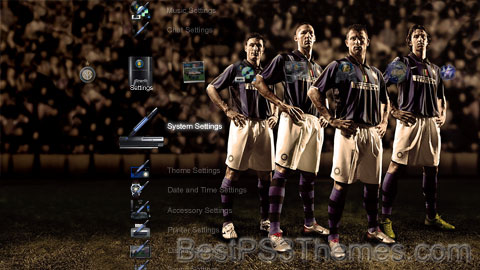Lewis Hamilton theme by Hamilton Fanatic
Download: LewisHamilton.p3t
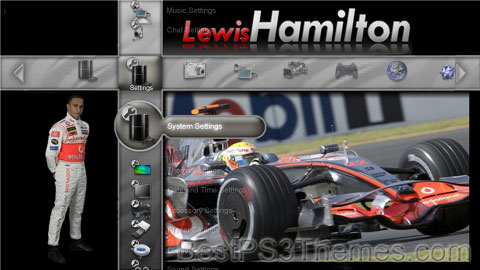
(16 backgrounds)
| ||
|---|---|---|
|
Rivalries |
||
Sir Lewis Carl Davidson Hamilton MBE HonFREng (born 7 January 1985) is a British racing driver competing in Formula One, driving for Mercedes. Hamilton has won a joint-record seven Formula One World Drivers' Championship titles (tied with Michael Schumacher), and holds the records for most wins (103), pole positions (104), and podium finishes (198), among others.
Born and raised in Stevenage, Hertfordshire, Hamilton joined the McLaren Young Driver Programme in 1998. This led to a Formula One drive with McLaren from 2007 to 2012, making him the first black driver to race in the series. In his debut season, Hamilton set numerous records as he finished runner-up to Kimi Räikkönen by one point. The following season, he won his maiden title in dramatic fashion—making a crucial overtake on the last lap of the last race of the season—to become the then-youngest ever Formula One World Champion. After six years with McLaren, Hamilton signed with Mercedes in 2013.
Changes to the regulations for 2014 mandating the use of turbo-hybrid engines saw the start of a highly successful period for Hamilton, during which he won six further drivers' titles. Consecutive titles came in 2014 and 2015 during an intense rivalry with teammate Nico Rosberg. Following Rosberg's retirement in 2016, Ferrari's Sebastian Vettel became Hamilton's closest rival in two championship battles, in which he twice overturned mid-season point deficits to claim consecutive titles again in 2017 and 2018. His third and fourth consecutive titles followed in 2019 and 2020 to equal Schumacher's record of seven drivers' titles. Hamilton surpassed 100 race wins and pole positions in 2021. He will join Ferrari for the 2025 season.
Hamilton has been credited with furthering Formula One's global following by appealing to a broader audience outside the sport, in part due to his high-profile lifestyle, environmental and social activism, and exploits in music and fashion. He has also become a prominent advocate in support of activism to combat racism and push for increased diversity in motorsport. Hamilton was listed in the 2020 issue of Time as one of the 100 most influential people globally, and was knighted in the 2021 New Year Honours.
Early life and education[edit]

Lewis Carl Davidson Hamilton was born on 7 January 1985 in Stevenage, Hertfordshire.[2] His father, Anthony Hamilton, is of Grenadian descent, while his mother, Carmen Larbalestier, is British, from Birmingham,[7] making him mixed-race;[8][9] Hamilton's parents separated when he was two, after which he lived with his mother and older half-sisters, Samantha and Nicola, until he was twelve.[10] Hamilton then lived with his father, stepmother Linda, and his half-brother Nicolas, who is also a professional racing driver.[11][12] Hamilton was raised a Catholic.[13]
Hamilton's father bought him a radio-controlled car when he was five.[14] Hamilton finished second in the national BRCA championship the following year against adult competition.[15] Being the only black child racing at his club, Hamilton was subjected to racist abuse.[14][16] Hamilton's father bought him a go-kart for Christmas when he was six and promised to support his racing career as long as he worked hard at school.[17] To support his son, Hamilton's father took redundancy from his position as an IT manager and became a contractor, sometimes working up to four jobs at a time including employment as a double glazing salesman, dishwasher, and putting up signs for estate agents,[18] while still attending his son's races.[19] Hamilton's father later set up his own IT company.[20] He continued to be Hamilton's manager until early 2010.[21][22]
Hamilton was educated at The John Henry Newman School, a voluntary aided Catholic secondary school in Stevenage.[23] Hamilton has said that at the age of five he took up karate to defend himself as a result of bullying at school.[24] He was also excluded from school for a period when he was mistakenly identified as having attacked a fellow student who was treated in hospital for his injuries.[25] In addition to racing, he played association football for his school team with eventual England international, Ashley Young.[20] Hamilton, an Arsenal fan, said that if Formula One had not worked for him, he would have been a footballer or a cricketer, having played both for his school teams.[26] In February 2001, he began studies at Cambridge Arts and Sciences (CATS), a private sixth-form college in Cambridge.[27]
Junior racing career[edit]
Karting[edit]
Hamilton began karting in 1993 and quickly began winning races and cadet class championships.[28][29] Two years later, he became the youngest driver to win the British cadet karting championship at the age of ten. That year, Hamilton approached McLaren Formula One team boss Ron Dennis at the Autosport Awards for an autograph and said: "Hi. I'm Lewis Hamilton. I won the British Championship and one day I want to be racing your cars."[18] Dennis wrote in Hamilton's autograph book: "Phone me in nine years, we'll sort something out then."[30]
When Hamilton was 12, Ladbrokes took a bet, at 40/1 odds, that Hamilton would win a Formula One race before the age of 23; another predicted, at 150/1 odds, that he would win the World Drivers' Championship before he was 25.[31] In 1998, Dennis called Hamilton following his second Super One series and British championship wins,[15] to offer Hamilton a role in the McLaren driver development programme.[8] The contract included an option of a future Formula One seat, which would make Hamilton the youngest driver to secure a contract that later resulted in a Formula One drive.[28]
He's a quality driver, very strong and only 16. If he keeps this up I'm sure he will reach F1. It's something special to see a kid of his age out on the circuit. He's clearly got the right racing mentality.
—Michael Schumacher, speaking about Hamilton in 2001[32]
Hamilton continued his progress in the Intercontinental A (1999), Formula A (2000) and Formula Super A (2001) ranks, and became European Champion in 2000 with maximum points. In Formula A and Formula Super A, racing for TeamMBM.com, his teammate was Nico Rosberg, who would later drive for the Williams and Mercedes teams in Formula One; they would later team up again for Mercedes from 2013 to 2016. Following his karting successes, the British Racing Drivers' Club made him a "Rising Star" Member in 2000.[33] In 2001, Michael Schumacher made a one-off return to karts and competed against Hamilton along with other future Formula One drivers Vitantonio Liuzzi and Nico Rosberg. Hamilton ended the final in seventh, four places behind Schumacher. Although the two saw little of each other on the track, Schumacher praised the young Briton.[34]
Formula Renault and Formula Three[edit]
Hamilton began his car racing career in the 2001 British Formula Renault Winter Series, finishing fifth in the standings.[15] This led to a full 2002 Formula Renault UK campaign with Manor Motorsport in which he finished fifth overall.[35] He remained with Manor for another year, winning the championship ahead of Alex Lloyd.[36] Having clinched the championship, Hamilton missed the last two races of the season to make his debut in the season finale of the British Formula 3 Championship.[37] In his first race he was forced out with a puncture,[38] and in the second he crashed out and was taken to hospital after a collision with teammate Tor Graves.[39]
Asked in 2002 about the prospect of becoming one of the youngest ever Formula One drivers, Hamilton replied that his goal was "not to be the youngest in Formula One" but rather "to be experienced and then show what I can do in Formula One".[40] He made his debut with Manor in the 2004 Formula 3 Euro Series, ending the year fifth in the championship.[41] He also won the Bahrain F3 Superprix,[42] and twice raced in the Macau F3 Grand Prix.[43][44] Williams had come close to signing Hamilton but did not because BMW, their engine supplier at the time, would not fund him.[45] Hamilton eventually re-signed with McLaren. According to then McLaren executive and future CEO Martin Whitmarsh, who was responsible for guiding Hamilton through the team's young driver programme, he and Anthony Hamilton had a "huge row" at the end of the season, with his father pushing for him to move up to GP2 for 2005, while Whitmarsh felt that he should remain in Formula 3 for a second season, culminating in Whitmarsh tearing up Hamilton's contract; however, Hamilton called Whitmarsh six weeks later and re-signed with the team.[18]
Hamilton first tested for McLaren in late 2004 at Silverstone.[46] Hamilton moved to the reigning Euro Series champions ASM for the 2005 season and dominated the championship, winning 15 of the 20 rounds.[15] He also won the Marlboro Masters of Formula 3 at Zandvoort.[47] After the season British magazine Autosport featured him in their "Top 50 Drivers of 2005" issue, ranking Hamilton 24th.[15]
GP2[edit]
Hamilton moved to ASM's sister GP2 team, ART Grand Prix, for the 2006 season.[48] Hamilton won the GP2 championship at his first attempt, beating Nelson Piquet Jr. and Alexandre Prémat.[49] He secured a dominant win at the Nürburgring, despite a penalty for speeding in the pit lane.[50] At his home race at Silverstone, Hamilton overtook two rivals at Becketts, a series of high-speed bends where overtaking is rare.[51] In Istanbul he recovered from a spin that left him in eighteenth place to take second.[52] Hamilton won the title in unusual circumstances, inheriting the final point he needed after Giorgio Pantano was stripped of fastest lap in the Monza feature race.[53]
Hamilton's success in the GP2 championship coincided with a vacancy at McLaren following the departure of Juan Pablo Montoya to NASCAR and Kimi Räikkönen to Ferrari.[54][55] After months of speculation on whether Hamilton, Pedro de la Rosa or Gary Paffett would be paired with defending champion Fernando Alonso for 2007, Hamilton was confirmed as the team's second driver.[56] He was told of McLaren's decision at the end of September, but the news was not made public for almost two months, for fear that it would be overshadowed by Michael Schumacher's retirement announcement.[57]
Formula One career[edit]
McLaren (2007–2012)[edit]

Hamilton's first season in Formula One saw him partner two-time and defending World Champion Fernando Alonso at McLaren, a team that used works Mercedes engines and was 40% owned by the German manufacturer at the time.[58] Hamilton is the first and as of 2024[update] the only black driver to race in the series.[59][60][61] After finishing on the podium in his debut,[62] Hamilton went on to set several records as he finished runner-up in the 2007 World Drivers' Championship to Kimi Räikkönen by one point,[63] including those for the most consecutive podium finishes from debut (9), the joint most wins in a debut season (4) and the most points in a debut season (109).[64] Throughout the season, Hamilton and Alonso were involved in a number of incidents which resulted in tensions between both drivers and the team, culminating in Alonso and McLaren terminating their contract by mutual consent in November. Following a successful first season at McLaren, Hamilton signed a multi-million-pound contract to stay with the team until 2012.[65]
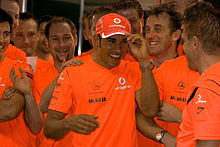
Aberdeen FC
Aberdeen FC theme by PDSangster
Download: AberdeenFC.p3t
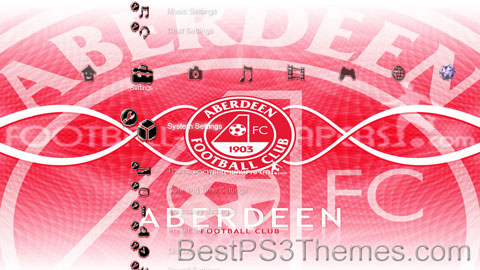
(1 background)
Redirect to:
This page is a redirect. The following categories are used to track and monitor this redirect:
|
Arsenal-PS3
Arsenal-PS3 theme by Isen aka Blaccat
Download: Arsenal-PS3.p3t
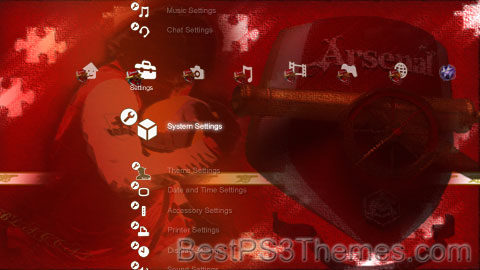
(3 backgrounds)
P3T Unpacker v0.12
Copyright (c) 2007. Anoop Menon
This program unpacks Playstation 3 Theme files (.p3t) so that you can touch-up an existing theme to your likings or use a certain wallpaper from it (as many themes have multiple). But remember, if you use content from another theme and release it, be sure to give credit!
Download for Windows: p3textractor.zip
Instructions:
Download p3textractor.zip from above. Extract the files to a folder with a program such as WinZip or WinRAR. Now there are multiple ways to extract the theme.
The first way is to simply open the p3t file with p3textractor.exe. If you don’t know how to do this, right click the p3t file and select Open With. Alternatively, open the p3t file and it will ask you to select a program to open with. Click Browse and find p3textractor.exe from where you previously extracted it to. It will open CMD and extract the theme to extracted.[filename]. After that, all you need to do for any future p3t files is open them and it will extract.
The second way is very simple. Just drag the p3t file to p3textractor.exe. It will open CMD and extract the theme to extracted.[filename].
For the third way, first put the p3t file you want to extract into the same folder as p3textractor.exe. Open CMD and browse to the folder with p3extractor.exe. Enter the following:
p3textractor filename.p3t [destination path]Replace filename with the name of the p3t file, and replace [destination path] with the name of the folder you want the files to be extracted to. A destination path is not required. By default it will extract to extracted.filename.
Rangers Media
Rangers Media theme by Garry McNally
Download: RangersMedia.p3t
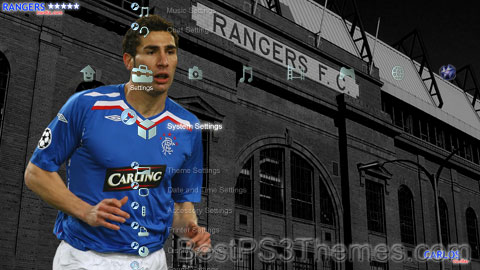
(4 backgrounds)
P3T Unpacker v0.12
Copyright (c) 2007. Anoop Menon
This program unpacks Playstation 3 Theme files (.p3t) so that you can touch-up an existing theme to your likings or use a certain wallpaper from it (as many themes have multiple). But remember, if you use content from another theme and release it, be sure to give credit!
Download for Windows: p3textractor.zip
Instructions:
Download p3textractor.zip from above. Extract the files to a folder with a program such as WinZip or WinRAR. Now there are multiple ways to extract the theme.
The first way is to simply open the p3t file with p3textractor.exe. If you don’t know how to do this, right click the p3t file and select Open With. Alternatively, open the p3t file and it will ask you to select a program to open with. Click Browse and find p3textractor.exe from where you previously extracted it to. It will open CMD and extract the theme to extracted.[filename]. After that, all you need to do for any future p3t files is open them and it will extract.
The second way is very simple. Just drag the p3t file to p3textractor.exe. It will open CMD and extract the theme to extracted.[filename].
For the third way, first put the p3t file you want to extract into the same folder as p3textractor.exe. Open CMD and browse to the folder with p3extractor.exe. Enter the following:
p3textractor filename.p3t [destination path]Replace filename with the name of the p3t file, and replace [destination path] with the name of the folder you want the files to be extracted to. A destination path is not required. By default it will extract to extracted.filename.
Raiders FIB
Raiders FIB theme by Vegas 34
Download: RaidersFIB.p3t
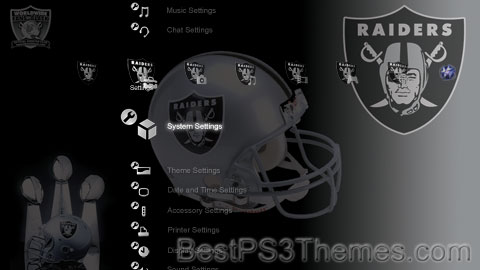
(1 background)
P3T Unpacker v0.12
Copyright (c) 2007. Anoop Menon
This program unpacks Playstation 3 Theme files (.p3t) so that you can touch-up an existing theme to your likings or use a certain wallpaper from it (as many themes have multiple). But remember, if you use content from another theme and release it, be sure to give credit!
Download for Windows: p3textractor.zip
Instructions:
Download p3textractor.zip from above. Extract the files to a folder with a program such as WinZip or WinRAR. Now there are multiple ways to extract the theme.
The first way is to simply open the p3t file with p3textractor.exe. If you don’t know how to do this, right click the p3t file and select Open With. Alternatively, open the p3t file and it will ask you to select a program to open with. Click Browse and find p3textractor.exe from where you previously extracted it to. It will open CMD and extract the theme to extracted.[filename]. After that, all you need to do for any future p3t files is open them and it will extract.
The second way is very simple. Just drag the p3t file to p3textractor.exe. It will open CMD and extract the theme to extracted.[filename].
For the third way, first put the p3t file you want to extract into the same folder as p3textractor.exe. Open CMD and browse to the folder with p3extractor.exe. Enter the following:
p3textractor filename.p3t [destination path]Replace filename with the name of the p3t file, and replace [destination path] with the name of the folder you want the files to be extracted to. A destination path is not required. By default it will extract to extracted.filename.
Gerrard-Torres
Gerrard-Torres theme by Jeffro_11
Download: Gerrard-Torres.p3t
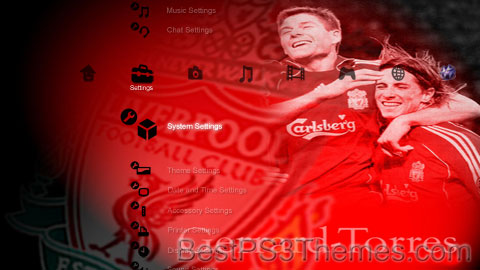
(1 background)
P3T Unpacker v0.12
Copyright (c) 2007. Anoop Menon
This program unpacks Playstation 3 Theme files (.p3t) so that you can touch-up an existing theme to your likings or use a certain wallpaper from it (as many themes have multiple). But remember, if you use content from another theme and release it, be sure to give credit!
Download for Windows: p3textractor.zip
Instructions:
Download p3textractor.zip from above. Extract the files to a folder with a program such as WinZip or WinRAR. Now there are multiple ways to extract the theme.
The first way is to simply open the p3t file with p3textractor.exe. If you don’t know how to do this, right click the p3t file and select Open With. Alternatively, open the p3t file and it will ask you to select a program to open with. Click Browse and find p3textractor.exe from where you previously extracted it to. It will open CMD and extract the theme to extracted.[filename]. After that, all you need to do for any future p3t files is open them and it will extract.
The second way is very simple. Just drag the p3t file to p3textractor.exe. It will open CMD and extract the theme to extracted.[filename].
For the third way, first put the p3t file you want to extract into the same folder as p3textractor.exe. Open CMD and browse to the folder with p3extractor.exe. Enter the following:
p3textractor filename.p3t [destination path]Replace filename with the name of the p3t file, and replace [destination path] with the name of the folder you want the files to be extracted to. A destination path is not required. By default it will extract to extracted.filename.
Lille OSC
Lille OSC theme by shadyslim59 (ludovic59110)
Download: LilleOSC.p3t
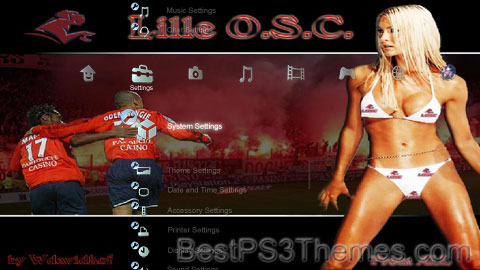
(3 backgrounds)
 | ||||
| Full name | Lille Olympique Sporting Club | |||
|---|---|---|---|---|
| Nickname(s) | Les Dogues (The Mastiffs) Les Nordistes (The Northmen) Les Lillois (The Lillois) La Machine de Guerre (The War Machine) | |||
| Short name |
| |||
| Founded | 23 September 1944 | |||
| Stadium | Stade Pierre-Mauroy | |||
| Capacity | 50,186 | |||
| Owner | Merlyn Partners SCSp | |||
| President | Olivier Létang | |||
| Head coach | Bruno Génésio | |||
| League | Ligue 1 | |||
| 2023–24 | Ligue 1, 4th of 18 | |||
| Website | Club website | |||
|
| ||||
Lille Olympique Sporting Club (French pronunciation: [lil ɔlɛ̃pik spɔʁtɪŋ klœb]), commonly referred to as LOSC, LOSC Lille or simply Lille, is a French professional football club based in Lille, Hauts-de-France that competes in Ligue 1, the top division of French football. Lille has played its home matches since 2012 at the Stade Pierre-Mauroy. The 50,186-capacity retractable roof venue is the fourth-largest football stadium in France.
Lille was founded as a result of a merger between Olympique Lillois and SC Fives in 1944. Both clubs were founding members of the French Division 1 and Olympique Lillois was the league's inaugural champions. The club's most successful period was the decade from 1946 to 1956, in the post-war period, when the team led by managers George Berry and André Cheuva won seven major trophies, including a League/Cup double in 1946, and was known as La Machine de Guerre (French for "The War Machine"). Having won another double in 2011, its fourth league title in 2021 as well as its first French super cup, Lille is the fourth best French club in the 21st century.
In domestic football, the club has won a total of four league titles, six Coupes de France and one Trophée des Champions since its foundation. In European football, Lille has participated in the UEFA Champions League eight times, reaching the knockout phase twice, competed in the UEFA Europa League on eight occasions and won the UEFA Intertoto Cup in 2004 after finishing as runners-up in 2002.
Nicknamed Les Dogues (French for "The Mastiffs"), the club is known for its academy which has produced and trained notable graduates, such as Eden Hazard, Mathieu Debuchy, Yohan Cabaye, Lucas Digne, Benjamin Pavard, Divock Origi and Martin Terrier. Throughout its history, Lille has cultivated a reputation for scouting, spotting and developing talent. Players like Mike Maignan, Gabriel, Sven Botman, Idrissa Gueye, Rafael Leão, Victor Osimhen and Jonathan David made a breakthrough after their arrival at the club and became famous playing for the Northmen. Lille has a long-standing rivalry with nearby side RC Lens, with whom they contest the Derby du Nord. Lille leads in the head-to-head record between the two rivals and in terms of total trophies won. Currently owned by Luxembourg-based investment fund Merlyn Partners SCSp, it's the fifth-most followed French sports club on social media.[1]
History[edit]
First decade of glory : The War Machine (1944–1955)[edit]

Before the Second World War, the city of Lille had two clubs at the top level; Olympique Lillois and SC Fives. Olympique Lillois were crowned domestic champions in 1932–33, the first in the history of the championship that was created in 1932, and were runners-up in 1935–36.[2] They also earned a USFSA Football Championship title in 1914, the French football top division before the creation of the French Division 1, and went to the Coupe de France final in 1939. Their neighbours, SC Fives, ranked second in 1933–34.[3] They also went to the Coupe de France final, being defeated by Girondins AS Port in 1941.[4] Weakened by the war, the two clubs decided to merge in the autumn of 1944, on 23 September, giving birth to Stade Lillois, renamed Lille Olympique Sporting Club a few weeks later.[5] On 25 November 1944, the club is officially registered under its new name.
For its first season, the newborn club reached the 1945 Coupe de France final, with a squad composed of the best players of both merging teams, who are mostly natives of the Nord department.[5] Next season, Lille won the double, beating Red Star in the 1946 Coupe de France Final and finishing at the first place of French Division 1 ahead of Saint-Étienne and Roubaix-Tourcoing. In 1947, Lille finished in the fourth place but came back to the Coupe de France final and retained the trophy, defeating Strasbourg. The club won the cup again in 1948 beating main rivals Lens, its third in a row, and were runners-up of the league the same year, behind Marseille that became the champions after a strong 1947–48 season finishing. They were also runners-up in 1948–49, 1949–50 and 1950–51.[5] On 24 June 1951, an exhausted Lille reached the Latin Cup final and lost against Gre-No-Li's AC Milan after having played 250 minutes in the span of two days.[6]
On 31 May 1953, they got back to winning and earned their fourth Coupe de France trophy in a 2–1 final win against FC Nancy, before 60,000 spectators. The club then won its second domestic title in 1953–54, having only conceded 22 goals within 34 games. After this season, Lille is praised for its defensive proficiency and acquired a reputation as a rock-solid defense.[5] A year later, Les Dogues earned their fifth Coupe de France in a 5–2 win against Bordeaux in the final.[4] This period of glory and hegemony, occurring after the war and the German occupation of France, has led to one of the club's nicknames: La Machine de Guerre (French for "The War Machine").[7] Within its first decade of existence, the club gathered the vast majority of its major trophies, winning two league titles and reaching the second place for four consecutive seasons. Lille, known as the best French club in the post-war period, accumulated five Coupe de France wins in seven finals, including five successive finals and winning the trophy three times in a row, one of the best performances in the history of the tournament.[8]
Decline and several spells in lower levels (1955–1978)[edit]

The 1955–56 season happened to be highly complicated. The club suffered from internal conflicts, Louis Henno was contested and certain players refused to play some matches. In the field, the Northmen were way too irregular and crumbly in defense, and finished in 16th place.[5] Lille were relegated for the first time in their history in 1956. This relegation is accompanied by aggravating financial consequences. Best players' departure is necessary to cover debts which are becoming substantial. Failing to rebuild a top team due to the increasingly poor financial situation, the club began a series of promotions and relegations. Promoted in 1957 by beating Rennes, Lille initially ended up to an unexpected 6th place. The club then finished in eighteenth place the following season; being relegated a second time. After a few years spent in Division 2, the club became a mid-table side in the late 1960s. From 1964 to 1968, the club managed somehow to avoid relegation to the lower level. After a long drought, the worst occurred when Lille abandoned its professional status on 23 June 1969, lacking facilities and resources.[5]
A few seasons spent in amateur leagues later, Lille recreated its professional team by entering the second division in 1970, finished at the top of the division at the end of the season. The club began a new series of promotions and relegations in the 1970s. During this decade, the club's accounts were largely in deficit. In order to cover debts, a support committee was founded and friendly matches were organized to raise funds.[5] Famous clubs like Marseille or Feyenoord as well as nearby Belgian teams like Anderlecht and Standard Liège agreed to play against Lille to help the northern team. However, these ticket revenues only temporarily improve the club's financial situation but the Lille city council was again forced to help and intervene.[9] At the lower level, Lille missed out on promotion in 1973 by one point but were crowned Division 2 champions the following year. After finishing twice in 13th place, during the 1974–75 and 1975–76 seasons, the club was once again relegated in 1977.[10][9]
Reconstruction and reorganization (1978–2000)[edit]

After years of back and forth, Lille finally returned to the top tier of French football at the end of the 1977–78 season. Until 1997, the club remained in the first division, becoming a perennial member of the Division 1. In the 1978–79, the Mastiffs had a good run and ended at 6th place, nearly qualifying for European competitions while being promoted. The following year, in July 1980, Lille was the first French club to opt for the status of a mixed economy company (SAEMS), of which the city of Lille became the majority shareholder and turned the club into a public-controlled enterprise.[11] The new financial sustainability allows the club's sporting stabilization in the elite division. LOSC then achieved some success stories in the decade, reaching the Coupe de France semi-finals in 1983 and 1985.[5]
However, presidents Jacques Amyot, Roger Deschodt and Jacques Dewailly all struggled to compete with the top teams in the country and saw Lille staying in the familiar surroundings of mid-table. In 1991, Lille then-coached by Jacques Santini finished in sixth place, just two points from the European places; this is the club's only appearance in the league table top half in the 1990s. After financial problems, Bernard Lecomte took over as president of the club in 1994 and saved it from administrative relegation the following year by negotiating with the governing bodies. During this period of austerity where the National Football League prohibited the club from recruiting, LOSC had to part ways with its star players, such as Antoine Sibierski or Miladin Bečanović, and chose to develop its youth academy. Yet another economic crisis brought the club to the brink of bankruptcy and led to relegation to the second division in 1997.[5][9]
While being in Division 2, the club was privatised and purchased in 1999 by Luc Dayan and Francis Graille. The team then trained by Bosnian coach Vahid Halilhodžić reconnected with success. Lille quickly recovered as Lille were head and shoulders over the other clubs during the 1999–2000 Division 2 season, the club dominated the championship thanks to excellent defense and finished champion with sixteen points ahead of its runner-up, being promoted back to the top.[5][9]
Back to the top and new double (2000–2017)[edit]

In just its first season back in the top flight 2000–01 French Division 1, Lille qualified for Europe for the first time in the club's history, booking its place in the 2001–02 Champions League. On the back of the club's new status, Lille entered into a decisive new era under the guidance of chairman and chief executive officer Michel Seydoux and coach Claude Puel. The club left the historical Stade Grimonprez-Jooris to join the Stadium Lille Métropole and became a regular on the European scene. Amongst its most emphatic results was the 1–0 victory over Manchester United at the Stade de France in 2005, the 2–0 triumph over Milan in San Siro in 2006 and the 1–0 home win over Liverpool in 2010.
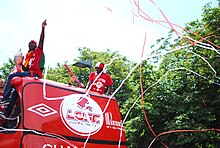
In the 2010s, Lille knew a steady development on and off the pitch, and has established itself as one of the most important clubs in French Ligue 1. First, the inauguration of the vast and modern Domaine de Luchin training complex in 2007 brings the club to a new era, the center being one of the largest in France. Roughly at the same time, the construction of the 50,000-capacity Grand Stade Lille Métropole (renamed later Stade Pierre-Mauroy), which opened in 2012, began on 29 March 2010 and will give the club the fourth-largest football stadium in France. Successive strong results and a sporting progression under head coach Rudi Garcia took the club back to the top of the French league. Fifty-six years after the club's last trophy, 2010–11 first team, led by home-grown players Yohan Cabaye, Mathieu Debuchy and Eden Hazard, won the club's second double after finishing at the 2010–11 Ligue 1 top spot and defeating Paris Saint-Germain in the 2011 Coupe de France final.[12][13]
In the 2011–12 and 2012–13 Ligue 1 seasons, Lille confirmed its place belong top French football teams, finishing successively at the second and sixth places and qualifying for the 2012–13 Champions League. In 2013, Garcia left to join Roma, while former Montpellier coach René Girard was appointed as new manager.[14] Under Girard, Lille finished at the third place in 2013–14, behind Zlatan Ibrahimović's Paris Saint-Germain and James Rodríguez's Monaco. After two years in charge of the club and a deceiving eight seed at the end of the 2014–15 Ligue 1 season, Girard left the club by mutual consent.
In May 2015, the Ivory Coast national team head coach Hervé Renard was appointed as the new manager. On 11 November 2015, Renard was terminated as manager and was replaced by Frederic Antonetti.[15][16] On 23 November 2016, a year after being appointed, Lille terminated Antonetti's contract with the club lying second last in the table.[17]
Campos and Galtier era: sustained success (2017–2021)[edit]
In early 2017, Lille appointed Luis Campos as sporting director and head of recruitment. A short time afterwards, the club announced the arrival of Argentine famous manager Marcelo Bielsa. In November 2017, Bielsa was suspended by Lille following an unauthorized trip to Chile with the club lying second from bottom on the table again and only managing 3 wins from the first 14 games of the season.[18] On 23 December 2017, Bielsa was terminated by Lille and replaced with former Saint-Etienne manager Christophe Galtier.[19] In a difficult 2017–18 season, Lille managed to avoid relegation to Ligue 2 by defeati
Ultra St. Pauli
Ultra St. Pauli theme by Highscorekiller
Download: UltraStPauli.p3t
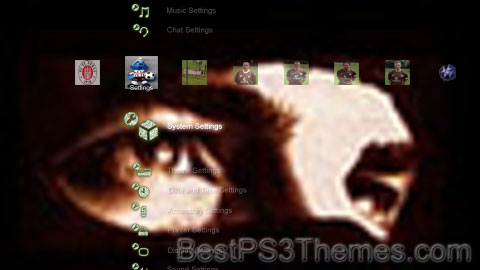
(4 backgrounds)
P3T Unpacker v0.12
Copyright (c) 2007. Anoop Menon
This program unpacks Playstation 3 Theme files (.p3t) so that you can touch-up an existing theme to your likings or use a certain wallpaper from it (as many themes have multiple). But remember, if you use content from another theme and release it, be sure to give credit!
Download for Windows: p3textractor.zip
Instructions:
Download p3textractor.zip from above. Extract the files to a folder with a program such as WinZip or WinRAR. Now there are multiple ways to extract the theme.
The first way is to simply open the p3t file with p3textractor.exe. If you don’t know how to do this, right click the p3t file and select Open With. Alternatively, open the p3t file and it will ask you to select a program to open with. Click Browse and find p3textractor.exe from where you previously extracted it to. It will open CMD and extract the theme to extracted.[filename]. After that, all you need to do for any future p3t files is open them and it will extract.
The second way is very simple. Just drag the p3t file to p3textractor.exe. It will open CMD and extract the theme to extracted.[filename].
For the third way, first put the p3t file you want to extract into the same folder as p3textractor.exe. Open CMD and browse to the folder with p3extractor.exe. Enter the following:
p3textractor filename.p3t [destination path]Replace filename with the name of the p3t file, and replace [destination path] with the name of the folder you want the files to be extracted to. A destination path is not required. By default it will extract to extracted.filename.
FC Internazionale
Kevin Garnett
Kevin Garnett theme by Frank Skalka
Download: KevinGarnett.p3t
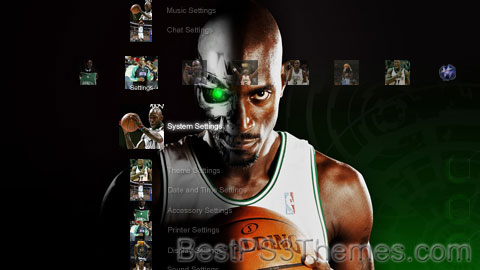
(5 backgrounds)
Kevin Maurice Garnett (/ɡɑːrˈnɛt/ gar-NET; born May 19, 1976) is an American former professional basketball player who played for 21 seasons in the National Basketball Association (NBA). Nicknamed "The Big Ticket," Garnett is considered one of the greatest power forwards of all time, known for his intensity, versatility, and defensive ability.[1] As of 2020, he is one of five NBA players to have won both the NBA Most Valuable Player Award and the NBA Defensive Player of the Year Award.[n 1]
In high school, Garnett was a 1995 McDonald's All-American at Farragut Career Academy and a national player of the year award.[3][4] He entered the 1995 NBA draft, where he was selected with the fifth overall pick by the Minnesota Timberwolves and became the first NBA player drafted directly out of high school in 20 years. Garnett made an immediate impact with the Minnesota Timberwolves, leading them to eight consecutive playoff appearances. In 2004, he led the Timberwolves to the Western Conference Finals and won the NBA MVP Award. He was named the NBA Defensive Player of the Year with the Boston Celtics during the 2007–08 season, his first with the team.
Garnett was traded to the Celtics in 2007, helping lead them to the 2008 NBA Finals and beat the Los Angeles Lakers, while also finishing in third place for the MVP award.[5] In 2013, Garnett was included in a second headline trade that sent him to the Brooklyn Nets with longtime Celtic Paul Pierce. In 2015, Garnett was traded back to Minnesota. He announced his retirement from professional basketball in September 2016. He was inducted into the Naismith Memorial Basketball Hall of Fame in 2020 and named to the NBA 75th Anniversary Team in 2021.
During his NBA career, Garnett was named to 15 All-Star Games, winning the All-Star MVP award in 2003.[n 2] He was named to the All-NBA Team nine times and the NBA All-Defensive Team 12 times.[6] Garnett also holds several Timberwolves franchise records.
Garnett made his feature film debut, playing a fictionalized version of himself, in the 2019 film Uncut Gems.[7][8]
Early life and high school career[edit]
Garnett was born on May 19, 1976, in Greenville, South Carolina.[9] He is the middle child and has two sisters.[10] Garnett's mother, Shirley Garnett, never married his father, O'Lewis McCullough, with their relationship ending shortly after his birth. Garnett grew up with his mother and stepfather.[11]
Garnett fell in love with the sport of basketball while attending Hillcrest Middle School, although he did not play organized basketball until high school. In his first three years of high school, Garnett attended Mauldin High School in Mauldin, South Carolina, and played on the school's basketball team. However, during the summer before his senior year of high school, Garnett was in the general vicinity of a fight between black and white students. Although not directly involved, Garnett was one of three students arrested for second-degree lynching, a charge that was expunged through a pre-trial intervention.[12] Due to the racially charged incident and fearful of being a target, Garnett decided to leave Mauldin High[13] and transferred to Farragut Career Academy in Chicago's West Side, for his senior year of high school.
Living with his sister in Chicago, Garnett led Farragut to a 28–2 record and was named National High School Player of the Year by USA Today. He was also named Mr. Basketball for the state of Illinois after averaging 25.2 points, 17.9 rebounds, 6.7 assists and 6.5 blocks while shooting 66.8% from the field. In four years of high school, Garnett posted an impressive 2,553 points, 1,809 rebounds and 737 blocked shots. In high school, Garnett played alongside Ronnie Fields, who also became a professional basketball player. Garnett was named the Most Outstanding Player at the McDonald's All-American Game after registering 18 points, 11 rebounds, 4 assists, and 3 blocked shots, and then declared himself eligible for the 1995 NBA draft.[14] To mark the 35th anniversary of the McDonald's All-American High School Boys Basketball Game, Garnett was honored as one of 35 Greatest McDonald's All-Americans.[4] Garnett's decision not to play college basketball was influenced in part by his failure to score well enough on the ACT to meet NCAA requirements for freshman eligibility.[15] Garnett told Student Sports Magazine in 1995 that if he went to college, he would have played college basketball for the University of Maryland, a moderate surprise at the time considering, while Maryland and North Carolina[16] were contenders, the University of Michigan were viewed as front-runners in Garnett's recruitment.[17] However, in the years since his recruitment, several figures close to the recruitment, including former Nike executive Sonny Vaccaro, as well as Garnett himself, have stated that he would have likely attended Michigan, influenced by an appreciation of the Fab Five and Chris Webber, in particular.[18][19][20]
A Chicago area high school coach referred Garnett to Eric Fleisher, then agent for 18 NBA players and son of first National Basketball Players Association head Larry Fleisher, to discuss the possibility of going to the NBA straight out of high school. Two weeks later at the Lakeshore Athletic Club, Fleisher ran a small tryout where Garnett dominated against older, more experienced competition. Fleisher then set Detroit Pistons assistant John Hammond to run the drills at another workout at the University of Illinois-Chicago to gauge NBA interest. Representatives from the 13 teams with lottery picks, with Kevin McHale, Elgin Baylor, Flip Saunders, and Kevin Loughery among them, were in the workout that was scheduled around the same time as a pre-draft tryout camp. The workout included Garnett touching the box painted on the backboard above the rim multiple times, and McHale giving Garnett tips on shooting jump shots. An hour before going to the 1995 NBA draft in the Toronto SkyDome, his coach at Farragut, William (Wolf) Nelson, gave encouragement and told Garnett that he passed the last SAT test he took with a score of 970.[21][22]
Professional career[edit]
Minnesota Timberwolves (1995–2007)[edit]
Early years (1995–1997)[edit]
Garnett was drafted with the fifth overall pick in the 1995 NBA draft by the Minnesota Timberwolves, and became the first player to be drafted directly out of high school since 1975.[23] Since joining the NBA for the 1989–90 season, the Timberwolves had not won more than 29 games in any season.[24] In Garnett's rookie season, the Timberwolves were in the midst of a transition phase; they replaced Bill Blair with Flip Saunders as head coach early in the season, and made several trades. Garnett initially came off the bench in his rookie year, but moved into the starting lineup soon after Saunders became head coach and with the urging of Sam Mitchell. In the final 42 games of the year, averaged 14 points, 8.4 rebounds and 2.26 blocks as a starter.[21] In his rookie year, Garnett and fellow newcomer Tom Gugliotta carried the scoring load. Garnett did not immediately leap to stardom as later prep-to-pro prospects such as Amar'e Stoudemire, LeBron James and Dwight Howard would, but he did have a very respectable rookie year. He was voted to the All-Rookie Second Team on averages of 10.4 points, 6.3 rebounds, and 1.8 assists per game.[6] Despite having some promising players, the Timberwolves suffered through their seventh consecutive sub-30 win season and failed to make the playoffs. At the time, Garnett was the youngest NBA player in history at 19 years and 11 months of age.[14]
Before the 1996–97 season, the Timberwolves made a draft-day trade for point guard Stephon Marbury of the Georgia Tech Yellow Jackets. During the season, Garnett posted improved averages of 17.0 points, 8.0 rebounds, 3.1 assists, 2.1 blocks and 1.7 steals.[6] He also had two games where he registered eight blocks.[14] With a 40–42 record, the Timberwolves made their first playoff appearance in franchise history, Garnett and Gugliotta made their first All-Star appearances, and Marbury established himself as a valuable young lead guard. However, the Houston Rockets, led by Hakeem Olajuwon, Clyde Drexler, and Charles Barkley, proved to be too much as the Timberwolves were swept 3–0 in the first round of the 1997 NBA Playoffs.
Franchise player (1997–2001)[edit]
In August 1997, Garnett and Fleisher turned down the Timberwolves' offer of a contract worth $102 million over six years. They thought there would be more offered to them on the basis of the signings of $105 million over seven years for Alonzo Mourning of the Miami Heat and $100.8 million over seven years for Juwan Howard with the Washington Bullets. To get out of the spotlight while negotiations were ongoing, Garnett stayed in Fleisher's Westchester County home, north of New York City. One hour before the deadline on 1 October 1997,[21] the Timberwolves and Garnett agreed on a six-year contract extension that was worth an unparalleled $126 million.[14] The contract was considered a risky move and many analysts speculated that the deal would make it impossible for the Wolves to sign new players or even keep their own. The enormous size of Garnett's contract was considered, by numerous sports writers, a major cause of labor tensions between players and owners that led to a lockout which shortened the 1998–99 NBA season. Despite the furor over his new contract, Garnett continued to improve, averaging 18.5 points, 9.6 rebounds, 4.2 assists, 1.8 blocks, and 1.7 steals per game. Again, he was an All-Star, and the Timberwolves finished with their first winning record in franchise history (45–37 for the season). For the second consecutive year, the young Timberwolves bowed out of the playoffs in the first round, this time losing 3–2 to the Seattle SuperSonics and superstar point guard Gary Payton. The two wins against the Sonics marked the Wolves' first-ever playoff game wins. The off-season started poorly for the Timberwolves though as 20-point per game scorer Tom Gugliotta left for the Phoenix Suns.

In the lockout-shortened season that followed, Garnett broke through as a superstar. Putting up stats of 20.8 points, 10.4 rebounds, 4.3 assists, and 1.8 blocks per game,[6] he was named to the All-NBA Third Team. However, midway through the season, Stephon Marbury was traded to the New Jersey Nets. Although the Wolves received two-time All-Star Terrell Brandon in return, they were not able to overcome the discord and limped into the playoffs as the eighth seed with a 25–25 record. The Wolves were defeated in the first round again, this time losing 3–1 to the eventual champion San Antonio Spurs who were led by young superstar and eventual NBA Finals MVP Tim Duncan. In the 1999–2000 NBA season, Garnett continued his notable play, averaging 22.9 points, 11.8 rebounds, 5.0 assists, 1.6 blocks, and 1.5 steals per game. Garnett also made the first of his four All-NBA First Team appearances and came in second place in the MVP voting.[6] Assisted by sharpshooting rookie forward Wally Szczerbiak and steady veteran Terrell Brandon, the Wolves posted a franchise-best 50–32 record, but succumbed in the first round to the Portland Trail Blazers 3–1.
On May 20, 2000, Timberwolves' guard and Garnett's close friend Malik Sealy was killed by a drunk driver shortly after celebrating Garnett's 24th birthday.[25] Later that year, the NBA ruled that the free-agent signing of Joe Smith was illegal. The league punished the team for the illegal signing by stripping them of three first-round draft picks, fining Glen Taylor (the owner of the team) $3.5 million, and banning general manager Kevin McHale for one year. In the 2000–01 NBA season, Garnett led the Wolves to a 47–35 record and made the All-NBA Second Team, but again, the Wolves did not survive the first round of the playoffs, losing to the Spurs 3–1.
MVP and division champions (2001–2004)[edit]
In the 2001–02 season, Garnett posted another notable season, his averages of 21.2 points, 12.1 rebounds, 5.2 assists, 1.6 blocks and 1.2 steals per game enough for another All-NBA Second Team nomination. However, the Timberwolves bowed out in the first round for the sixth consecutive time, this time getting swept 3–0 by the Dallas Mavericks led by Michael Finley, Steve Nash, and Dirk Nowitzki. Garnett's next season was one of the best of his career, his 23.0 ppg / 13.4 rpg / 6.0 apg / 1.6 bpg / 1.4 spg season earning him his second All-NBA First Team nomination and second place in the MVP voting.[14] The Timberwolves posted a good 51–31 record, but for the seventh consecutive time, they did not make it out of the first round, this time losing to the Los Angeles Lakers 4–2.
In the 2003–04 season, things finally seemed to come together for Garnett. In past years, the Wolves had practically been a one-man show, but now, the Timberwolves had made two valuable acquisitions: highly talented but volatile swingman Latrell Sprewell and the seasoned two-time NBA champion Sam Cassell, who supplanted Troy Hudson at point guard. In addition, defensive center Ervin Johnson complemented the inconsistent Michael Olowokandi. Powered by the best supporting cast up to this point in his career, Garnett averaged 24.2 points, 13.9 rebounds, 5.0 assists, 2.2 blocks and 1.5 steals per game for the season. Having recorded career-highs in points, rebounds, blocks and leading the league rebounds, Garnett was named the league Most Valuable Player for the first time in his career.[6] With a franchise-record 58 wins, the Wolves stormed into the playoffs, and finally conquered their playoff bane by defeating the Denver Nuggets 4–1 in the first round. After disposing of the strong Sacramento Kings 4–3 in the Western Conference semi-finals, Garnett and the Timberwolves met the Lakers in the Western Conference Finals. There, playmaker Cassell went down with a back injury. With reserve point guard Hudson also injured, the Timberwolves alternated between third playmaker Darrick Martin and shooting guard Fred Hoiberg at the "one", or even running Garnett himself as point forward or a real point guard. The Los Angeles Lakers pulled off a 4–2 victory in the series.
Frustration (2004–2007)[edit]
On January 4, 2005, Garnett scored a career high 47 points to go along with 17 rebounds in a 115–122 loss to the Phoenix Suns.[26] He was also named to the All-NBA Second Team,[6] but the Timberwolves failed to make the playoffs for the first time in eight years with a record of 44–38. The 2005–06 season brought more frustration for Garnett. Sprewell turned down a three-year, $21 million extension, and the Wolves wary of his injuries and age, traded Cassell for the much less effective Marko Jarić, and the team's record for 2005–06 fell to 33–49. Despite Garnett's play, the team logged the second-worst record since Garnett joined the franchise. The Timberwolves' record dropped further in 2006–07, going 32–50 that season. In both of those seasons, Garnett earned All-NBA Third Team honors.
During the 2007 off-season, Glen Taylor admitted that although he planned on retaining Garnett, he finally listened to trade offers.[27] Garnett's name was mentioned in various trade rumors involving the Chicago Bulls, Los Angeles Lakers, Golden State Warriors, Indiana Pacers, Boston Celtics, Phoenix Suns, and Dallas Mavericks.[28][29][30][31] Garnett later confirmed that his preferred trade destinations were the Lakers, Celtics, and Suns.[32] He had initially contacted Lakers superstar Kobe Bryant about joining the team as the Lakers were his initial top choice but Bryant didn't answer or return the calls. Garnett stated, "I'm just being honest with everybody. I wanted to link with Kobe. Kobe and I had a different connect. When Kobe-Shaq went on their little thing, a lot of people went with Shaq. A lot of people didn't even fuck with Kobe. You know, Kobe, whatever. One of the very few to just stay with him. I was a neutral guy, anyway. I show everybody love. I tried to link with him, and I couldn't get him on the line."[32] The Lakers originally had a trade framework in place that involved Lamar Odom and Andrew Bynum.[32]
Boston Celtics (2007–2013)[edit]
NBA championship, DPOY award and injury (2007–2009)[edit]






